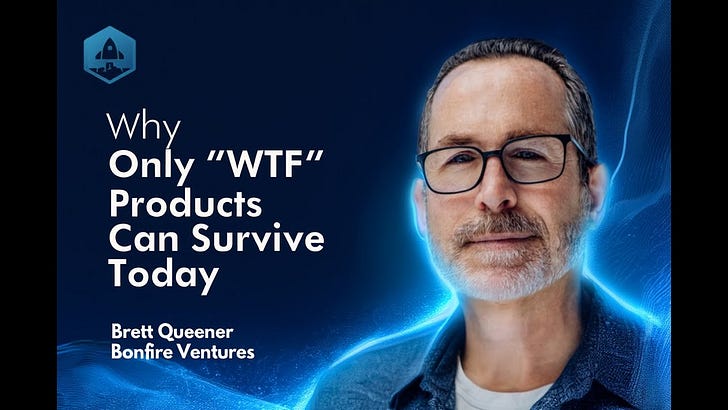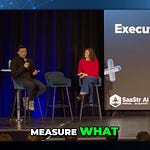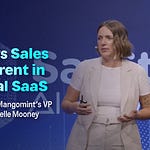How do you sell against the competition or become a market leader in a very crowded space? SaaStr’s CRO Confidential podcast host Sam Blond chats with the CRO of Apollo, Leandra Fishman, about just that. Leandra has over 30 years of experience leading large sales and revenue teams. This hypergrowth platform raised $100M at a $1.6B valuation in a challenging fundraising environment.
Apollo is a next-gen sales tool that combines sales intelligence and execution workflows with AI. When Sam was at Brex in 2018, the tech stack usually consisted of Salesforce, ZoomInfo, Gong, and Outreach. Today, that tech stack would be different because of AI-enabled companies like Apollo.
How did Apollo become a market leader in a hypercompetitive space?
How to Differentiate from the Competition in a Crowded Space
When you think of companies like Hubspot and what they did with inbound marketing in a crowded space, they offered a better in-house solution that wasn’t cobbled together. What they did for marketers, Apollo is trying to do for sales.
To sell against the competition, you have to differentiate yourself. How do you do that? For Apollo, Leandra’s sales model is built around a Product-Led Growth (PLG) motion. They were the first to get to millions of users at scale and found that their key differentiators in selling to sellers were:
Sales leaders and reps needed to see value quicker. They want to know how quickly they can book a meeting or generate pipeline, not waste 3 weeks onboarding to a new sales tool.
It needed to be accessible and easy for end users, and for Apollo, that meant a hyperfocus on accessibility for SMBs. So Apollo users can be free forever at the SMB scale and still gain value from the platform.
Apollo’s product actually gets better with scale, so they have a community with millions of free users unlocking that network effect. In a way, how they scale their GTM has created a virtuous cycle that helps them keep offering the best data set, and therefore bringing in new people to buy it. When you create a “must-have” product, it fosters a community around it, bringing in more and more of the type of users you’re after. They also actively encourage users to trial competitive apps either alongside or directly against their product and have found success in winning these trails.
Highlighting Your Product vs. Selling Too Aggressively — How to Handle Buyer Perception
When you target companies, should you call out the competition? That depends on how you do it. Leandra says she isn’t the type of leader to call out competition. When you know the value you have to offer, that’s how you win. Apollo tries to be a trusted advisor with a consultative mindset.
But sometimes, you do encourage prospective customers to compare products competitively, or you highlight why your product is better than the competition. So, how do you do this without being perceived as selling too aggressively? It’s easy to do a feature functionality comparison across competing products, but the magic happens when you understand the problem the customer is having and whether you’re the best solution to solve that problem. In a PLG model, if you aren’t getting what you came for, you take your money elsewhere. But if people want to talk to salespeople, you can ask them a question that makes talking about competitors better received, and it goes something like this…
”I understand you’re evaluating us vs. XYZ competitor. I’d love to learn more about your environment and tailor our product demo to what you’re using today. There are some big differences between us and other vendors. Would you like me to highlight those differences to compare and contrast?”
Ninety-nine times out of 100, the buyer will want you to highlight the product differences. If you ask how they want the conversation to go, and they want to hear about the differences, you’re not being too aggressive. You’re just doing what they asked.
How to Deal with Pricing in a Hyper-Competitive Environment
If you’re in a crowded space, it can feel like a race to the bottom on pricing, but it doesn’t have to be. Do you need to discount to match competitors or buy them out of contracts to compete in this space? No, you don’t.
Apollo is affordable, but that doesn’t mean they’re setting prices based on everyone else in the space. Instead, they’re pricing based on the value they provide. What most companies try to figure out as growth slows is how to cut costs and save money on the tech stack. Apollo can replace 5-7 tools with one solution, which can be more effective and less expensive. So, cost is one thing, but when you look at your overall tech spend and tech stack, that’s another. Apollo can offer lower prices because of their PLG machine, while others need an SDR, AE, etc, to grow their business.
When you have transparency and a hyper-efficient GTM strategy, you don’t have to take the same stance as everyone else on pricing. What Leandra has found is that legacy competitors are slashing pricing to compete with Apollo, so they don’t have to get into the race to the bottom or head-to-head pricing. What’s most important is going back to the value you provide.
Key Takeaways:
Get more transparent in pricing. Today’s customers have a different expectation than a few years ago. A decade ago, you couldn’t find any pricing on a website. Today, if you don’t show pricing, it can actually cause mistrust with customers.
Position yourself as the premium provider and be explicit about it, depending on your motion and segment.
Can You Successfully Hire Salespeople from Competitors
Leandra doesn’t hire from competitors. Instead of hiring from a competitor, she’s more focused on hiring salespeople and go-to-market leaders who know “the motion” vs. the product. It’s nice to come from the same type of industry and know the persona, but she wants someone who understands upselling from product-led growth, similar ACVs, and the stage of the company.
Working for a startup or hypergrowth company is much different than working for a larger company at a different stage. Instead, look for traits of people, not who they’ve sold to. Sometimes, you can bring over bad habits from competitors.
Some traits to look out for are:
Curiosity
Persistence
A proven track record
Sam added: “We made one hire from DocuSign at EchoSign. And then, there was Zenefits vs. Gusto, and then there was Brex vs. Ramp, and being on the receiving end of making a hire from one of those competitors, it has never worked out. And being on the end where you’re one of the competitors that ‘stole’ a hire directly from us, like the direct competitors, if DocuSign hired from EchoSign or if Ramp hired from Brex, they got the wrong person. The type of person that goes to a direct competitor is usually for personal reasons.”
The only time it might make sense to hire from a competitor is when someone successful at a competitor is pretty far down the list regarding where they stack rank in the space. If they’re the 4th or 5th best vendor in a competitive environment and they’ve found a way to be successful with an inferior product, then that person could bring value to your company because they’ve found a way to succeed with one hand tied behind their back.
Common Pitfalls Selling into a Competitive Market
Sam asks Leandra what patterns or pitfalls she’s observed within other companies selling into a competitive market. Her response? If you’re trying to sell up against something, you have to be clear on the value benefit you provide on the so-what and why.
Less is more depending on the product and buyer, and it comes down to how you differentiate your product to be better than anything else on the market. You don’t want to let competitors or customers control the narrative of your product, so you have to take control of the conversation by showing them how you are different and why that matters. If people come in with information from a competitor, you’re already on your back foot and the defensive. Lastly, depending on your segment, in-person relationships will almost always beat out virtual ones. What does that mean? Meet your buyers in person, and spend time building those relationships, especially as you move upmarket into larger deals.









